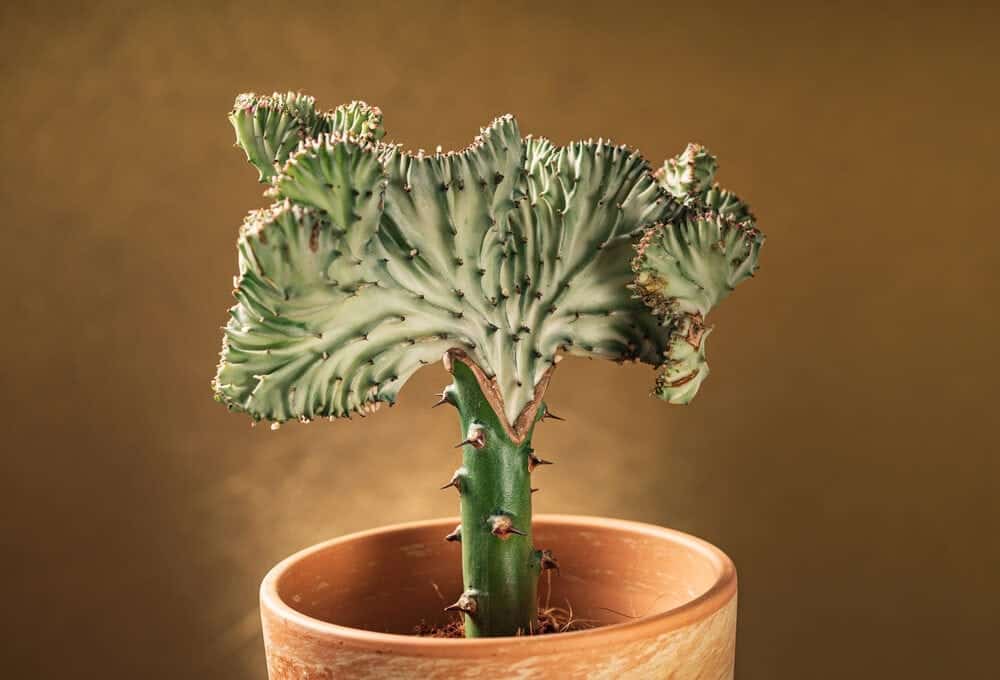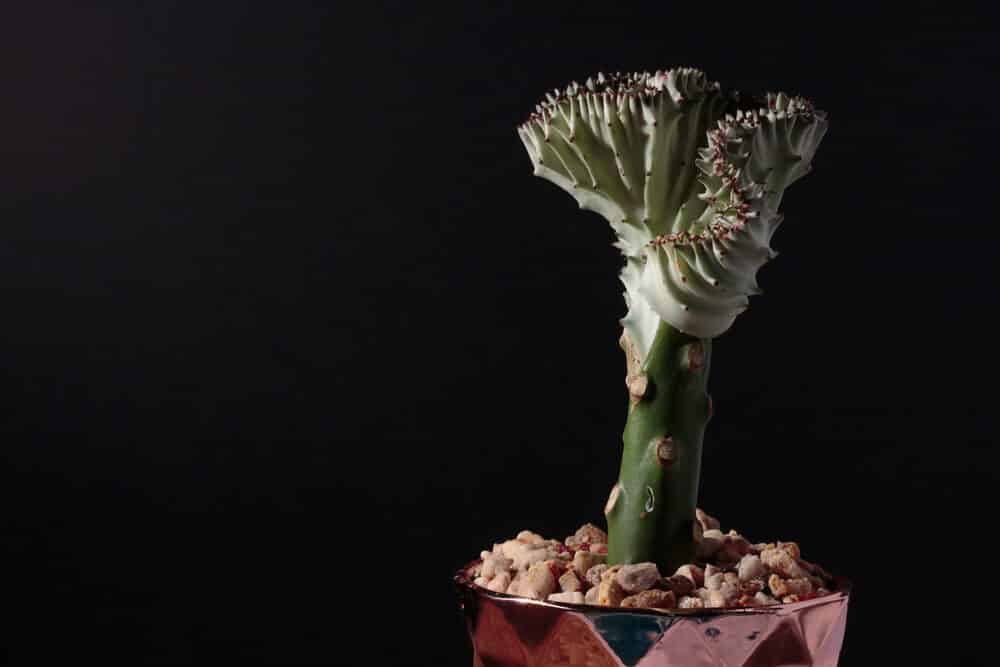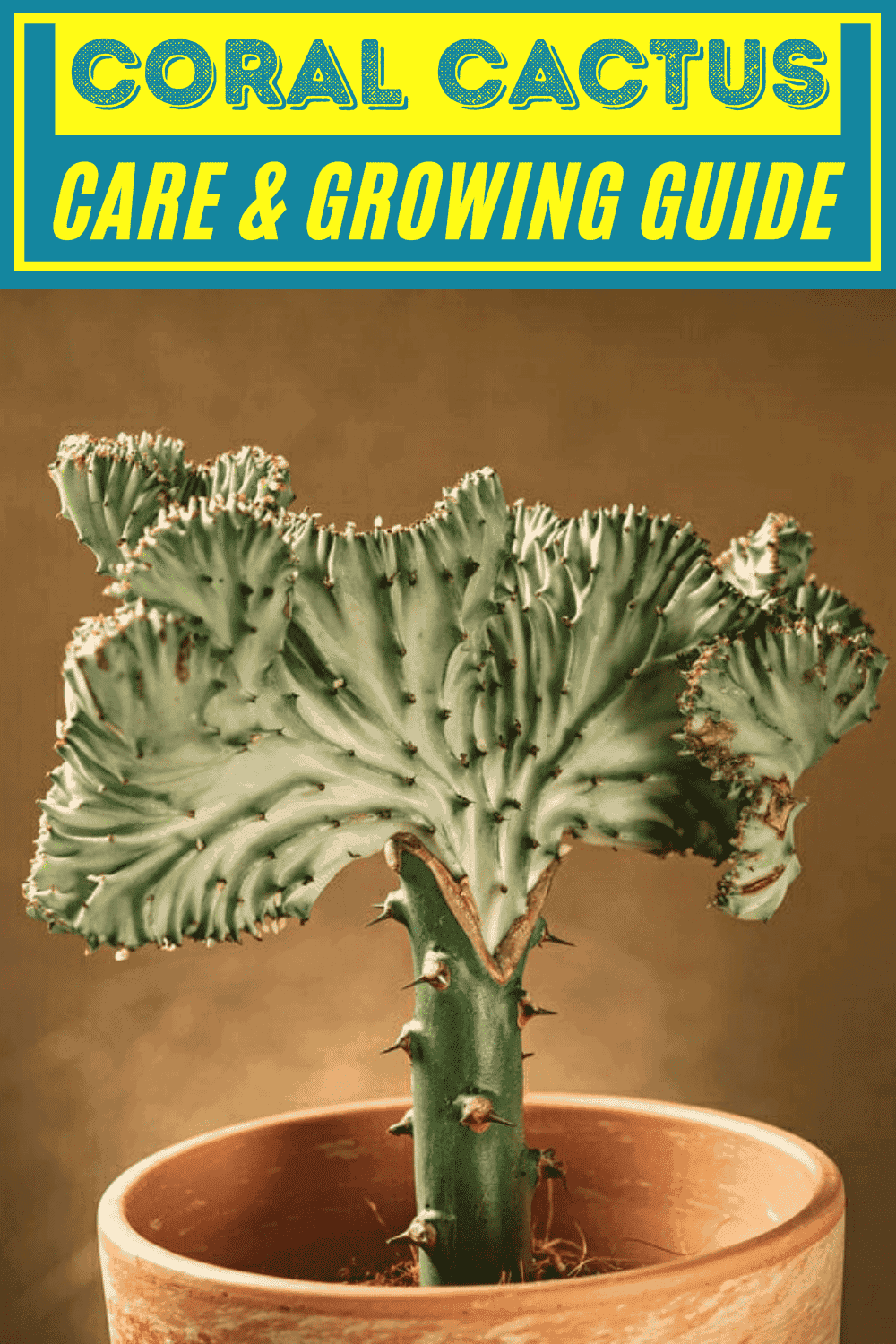There are over 2,000 types of succulents in the world, and the coral cactus plant is definitely one of the stranger plants.
Because of its shape, this plant is also known as the Candelabra plant. From the side view, it looks like a huge broccoli plant that has been cut in half.
Coral Cactus Care & Growing Guide
1. Light Requirement
A mix of full direct sunlight and partial shade will keep this plant nourished from the sun, but it needs to be protected during the hottest part of the day.
If you’re planning on propagating is plants, you will want to keep it under artificial lights. It does very well under artificial light, if it’s not crowded.
2. Water
Even though this is a cactus plant, surprisingly, this plant is not drought tolerant. Even so, it does not need to be watered often. To time it’s watering correctly, check if the roots near the drainage holes are dry first. If they are dry, it can be watered. If it is still moist, then wait and check again in two or three days.
Another way to know if the coral Cactus needs water is if its leaves are drooping.
From spring to summer, this plant must be watered with an inch of water whenever it is dry. This would be about once or twice a week. Water it less during the winter and increase watering it during early spring.

3. Climate and temperature
This plant enjoys warm weather and sunshine all year round. If you place the plant outside, bring it in before temperatures drop lower than 60 degrees F. Don’t let its place in the house rise above 80° either. It grows best in hardiness zones 10 and 11.
When it is indoors, make sure the coral cactus plant receives about 5 hours of direct sunlight every day.
4. Soil
Since it is a cactus, if it is in a pot, it will need to be planted in a cactus potting mix. The soil must drain quickly and never allow water to gather around the roots.
It only needs to be fertilized once per season, and not in the winter.
If it comes in a ceramic pot, quickly repot it in any other container. Ceramic does not allow the roots to have good airflow.
5. Repotting
When it is time to repot this plant, use a succulent potting mix and add some organic compost for an extra boost of nutrition.
To repot this plant, slowly pull the entire plant from out of its container. The potting soil in the new container should be fresh and also have sand in it to improve the soil. Do not damage the roots during transfer. Place it into the new container and plant its roots in a shallow area. Then press on the soil and make sure the plant cannot tip over.
If you’re thinking of planting baby cactus, you cannot do it by seed. It needs to be duplicated by grafting.
6. Speed of Growth
The crew cactus has a slow to medium rate of growth. It’s not meant to be trimmed because that can slow its growth even more.
7. Height and Spread
Under proper conditions, this plant still doesn’t grow very tall. Its height only reaches up to two feet, and its width is about a foot at the top of the plant and 6 inches around the base.

8. Trimming
Because of the strange nature of this plant and its lack of actual real leaves, You won’t really need to trim it. It only needs to be trimmed if it is affected by the disease, and parts of it are rotting.
Is the coral cactus plant poisonous?
Yes, every part of the coral cactus, stems, leaves, stalk, and roots, are poisonous and should not be ingested by animals or humans. If the sap from inside the plant gets on skin or fur, it will cause a terrible rash.
To be safe, you should always wear protective gloves before you handle this plant. If you have small children or animals, it would be best if you didn’t allow this plant to your home or garden.
Can the coral cactus Grow in Water?
No, if you try to grow the coral cactus plants in water, your efforts will be in vain because it will die. This plant is a cactus, which means it is drought tolerant and does not need to be overloaded with water.
Does the coral cactus have flowers, and how do I get them to bloom?
Many people wouldn’t call the ruffled edges of the cactus plant flowers, and they would be right. The ruffles are not flowers. Occasionally the coral cactus will bloom an actual regular flower. This flower might be either purple or pink. It usually happens when the plant reaches maturity.
All year round, instead of flowers, this cactus has sharp spines that can cause irritation and pain if it stabs through skin or fur. Okay
More like this: Pencil Cactus Plant Care & Growing Guide
Common coral cactus pests and diseases
- Powdery mildew is a fungus that slowly leaves a white waxy substance over the leaves and stems of your plant. If it doesn’t get too bad, it’s only an aesthetic issue, but too much growth, the mildew leads to stunted growth and dead Leaves. To fight it, remove parts of the coral cactus that are too weak and withering, and apply a fungicide like neem oil to it.
- Fungal rot occurs when the soil or the roots are too wet, and the weather is warm. If you catch it in time, you can cut off the disease parts and apply a fungicide to the rest of the coral. But if the fungus has killed more than a third of the plant and there’s no saving it. Throw away the coral cactus; do not compost it.
- mealybugs
Also read:
Conclusion
- This plant originally comes from Africa.
- This is not a drought-tolerant plant, and it likes to be watered at least twice a week.
- It is prone to fungal rot since it needs its roots to be wet.
- This plant has flowers, but they are small and pink or purple, but they are not pleasant to look at.
- The Coral cactus is poison and should be kept out of reach of pets and small children
- Because of how slower it grows,

Victoria is the owner and main author of hobby plants. She loves spending her free time in her garden planting and taking care of her plants. Victoria hopes you enjoy the content here!
![Queen Of The Night Flower [Complete Plant Care Guide] Queen Of The Night Flower [Complete Plant Care Guide]](https://www.hobbyplants.com/wp-content/uploads/2022/07/queen-of-the-night-flower-300x158.jpg)
![Mother Of Thousands Plant [Complete Plant Care Guide] Mother Of Thousands Plant [Complete Plant Care Guide]](https://www.hobbyplants.com/wp-content/uploads/2022/07/mother-of-thousands-plant-300x158.jpg)
![How Often Should You Water Pothos? [Complete Care Guide] How Often Should You Water Pothos? [Complete Care Guide]](https://www.hobbyplants.com/wp-content/uploads/2022/07/how-often-to-water-pothos-300x158.jpg)
![Can Snake Plants Live Outside? [COMPLETE CARE GUIDE] Can Snake Plants Live Outside? [COMPLETE CARE GUIDE]](https://www.hobbyplants.com/wp-content/uploads/2022/08/can-snake-plants-live-outside-300x158.jpg)
![Majesty Palm Plant Care: [Complete Beginner's Guide] Majesty Palm Plant Care: [Complete Beginner's Guide]](https://www.hobbyplants.com/wp-content/uploads/2022/08/majesty-palm-care-300x158.jpg)
![Exotic Angel Plant Care: [Complete Beginner's Guide] Exotic Angel Plant Care: [Complete Beginner's Guide]](https://www.hobbyplants.com/wp-content/uploads/2022/08/exotic-angel-plant-care-300x158.jpg)
![Do Coleus Like Sun Or Shade: [Complete Care Guide] Do Coleus Like Sun Or Shade: [Complete Care Guide]](https://www.hobbyplants.com/wp-content/uploads/2022/08/coleus-sun-or-shade-300x158.jpg)
![Snow White Waffle Plant: [Complete Care Guide] Snow White Waffle Plant: [Complete Care Guide]](https://www.hobbyplants.com/wp-content/uploads/2022/08/snow-white-waffle-plant-300x158.jpg)
![Waffle Plant Care: [Complete Beginner's Guide] Waffle Plant Care: [Complete Beginner's Guide]](https://www.hobbyplants.com/wp-content/uploads/2022/08/waffle-plant-300x158.jpg)
![Bird Of Paradise Plant Care: [Complete Beginner's Guide] Bird Of Paradise Plant Care: [Complete Beginner's Guide]](https://www.hobbyplants.com/wp-content/uploads/2022/08/bird-of-paradise-plant-300x158.jpg)
![Purple Passion Plant Care: [Complete Beginner's Guide] Purple Passion Plant Care: [Complete Beginner's Guide]](https://www.hobbyplants.com/wp-content/uploads/2022/08/purple-passion-plant-care-300x158.jpg)
![China Doll Plant Care: [Complete Beginner's Guide] China Doll Plant Care: [Complete Beginner's Guide]](https://www.hobbyplants.com/wp-content/uploads/2022/09/china-doll-plant-care-300x158.jpg)